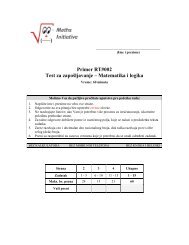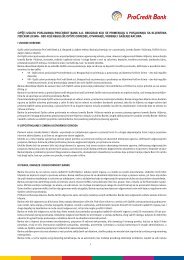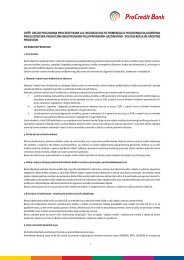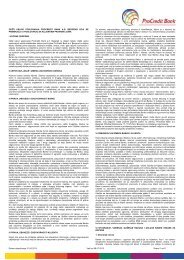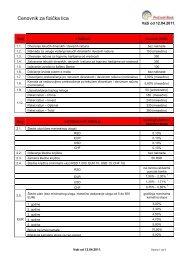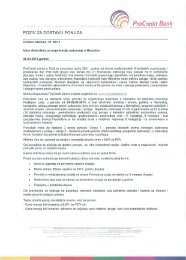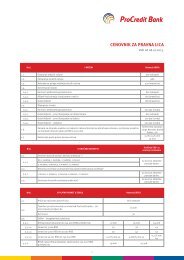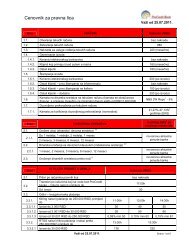Annual Report 2010 - ProCredit Bank
Annual Report 2010 - ProCredit Bank
Annual Report 2010 - ProCredit Bank
- No tags were found...
You also want an ePaper? Increase the reach of your titles
YUMPU automatically turns print PDFs into web optimized ePapers that Google loves.
54<br />
<strong>Annual</strong> <strong>Report</strong> <strong>2010</strong><br />
J) Sale and repurchase agreements<br />
Securities purchased under agreements to resell (‘reverse repos’)<br />
are recorded as Cash and balances with Central <strong>Bank</strong>. Reverse repos<br />
are included in cash and cash equivalents if they have a maturity<br />
less than three months from the date of acquisition. The difference<br />
between sale and repurchase price is treated as interest and<br />
accrued over the life of the agreements using the effective interest<br />
method. Securities lent to counterparties are also retained in the<br />
financial statements.<br />
K) Impairment of financial assets carried at amortized cost<br />
The Group assesses at each balance sheet date whether there is<br />
objective evidence that a financial asset or group of financial assets<br />
is impaired. A financial asset or a group of financial assets is<br />
impaired and impairment losses are incurred only if there is objective<br />
evidence of impairment as a result of one or more events that<br />
occurred after the initial recognition of the asset (a ‘loss event’) and<br />
that loss event (or events) has an impact on the estimated future<br />
cash flows of the financial asset or group of financial assets that<br />
can be reliably estimated.<br />
The criteria that the Group uses to determine that there is objective<br />
evidence of an impairment loss include:<br />
• Delinquency in contractual payments of principal or interest;<br />
• Cash flow difficulties experienced by the borrower (for example,<br />
equity ratio, net income percentage of sales);<br />
• Breach of loan covenants or conditions;<br />
• Initiation of bankruptcy proceedings;<br />
• Deterioration of the borrower’s competitive position;<br />
• Deterioration in the value of collateral; and<br />
• Downgrading below investment grade level.<br />
are relevant to the estimation of future cash flows for groups of<br />
such assets by being indicative of the debtors’ ability to pay all<br />
amounts due according to the contractual terms of the assets being<br />
evaluated.<br />
Future cash flows in a group of financial assets that are collectively<br />
evaluated for impairment are estimated on the basis of the contractual<br />
cash flows of the assets in the Group and historical loss experience<br />
for assets with credit risk characteristics similar to those<br />
in the Group. Historical loss experience is adjusted on the basis of<br />
current observable data to reflect the effects of current conditions<br />
that did not affect the period on which the historical loss experience<br />
is based and to remove the effects of conditions in the historical<br />
period that do not currently exist.<br />
Estimates of changes in future cash flows for groups of assets<br />
should reflect and be directionally consistent with changes in related<br />
observable data from period to period (for example, changes<br />
in unemployment rates, property prices, payment status, or other<br />
factors indicative of changes in the probability of losses in the<br />
Group and their magnitude). The methodology and assumptions<br />
used for estimating future cash flows are reviewed regularly by the<br />
Group to reduce any differences between loss estimates and actual<br />
loss experience.<br />
When a loan is uncollectible, it is written off against the related provision<br />
for loan impairment. Such loans are written off after all the<br />
necessary procedures have been completed and the amount of the<br />
loss has been determined.<br />
If, in a subsequent period, the amount of the impairment loss decreases<br />
and the decrease can be related objectively to an event<br />
occurring after the impairment was recognized (such as an improvement<br />
in the debtor’s credit rating), the previously recognized<br />
impairment loss is reversed by adjusting the allowance account.<br />
The amount of the reversal is recognized in the income statement<br />
in impairment charge for credit losses.<br />
The estimated period between a loss occurring and its identification<br />
is determined by local management for each identified portfolio.<br />
In general, the periods used vary between three months and 12<br />
months; in exceptional cases, longer periods are warranted.<br />
The Group first assesses whether objective evidence of impairment<br />
exists individually for financial assets that are individually<br />
significant, and individually or collectively for financial assets that<br />
are not individually significant. If the Group determines that no objective<br />
evidence of impairment exists for an individually assessed<br />
financial asset, whether significant or not, it includes the asset in<br />
a group of financial assets with similar credit risk characteristics<br />
and collectively assesses them for impairment. Assets that are individually<br />
assessed for impairment and for which an impairment<br />
loss is or continues to be recognized are not included in a collective<br />
assessment of impairment.<br />
The amount of the loss is measured as the difference between the<br />
asset’s carrying amount and the present value of estimated future<br />
cash flows (excluding future credit losses that have not been incurred)<br />
discounted at the financial asset’s original effective interest<br />
rate. The carrying amount of the asset is reduced through the<br />
use of an allowance account and the amount of the loss is recognized<br />
in the income statement.<br />
The calculation of the present value of the estimated future cash<br />
flows of a collateralized financial asset reflects the cash flows that<br />
may result from foreclosure less costs for obtaining and selling the<br />
collateral, whether or not foreclosure is probable.<br />
For the purposes of a collective evaluation of impairment, financial<br />
assets are grouped on the basis of similar credit risk characteristics<br />
(i.e. on the basis of the Group’s grading process that considers<br />
asset type, industry, geographical location, collateral type,<br />
past-due status and other relevant factors). Those characteristics<br />
L) Impairment of financial assets classified as available for sale<br />
The Group assesses at each date of the consolidated statement of<br />
financial position whether there is objective evidence that a financial<br />
asset or a group of financial assets is impaired. In the case of<br />
equity investments classified as available for sale, a significant or<br />
prolonged decline in the fair value of the security below its cost is<br />
objective evidence of impairment resulting in the recognition of an<br />
impairment loss. If any such evidence exists for available-for-sale<br />
financial assets, the cumulative loss – measured as the difference<br />
between the acquisition cost and the current fair value, less any<br />
impairment loss on that financial asset previously recognised in<br />
profit or loss – is removed from equity and recognised in the consolidated<br />
income statement. Impairment losses recognised in the<br />
consolidated income statement on equity instruments are not reversed<br />
through the consolidated income statement. If, in a subsequent<br />
period, the fair value of a debt instrument classified as available<br />
for sale increases and the increase can be objectively related<br />
to an event occurring after the impairment loss was recognised in<br />
profit or loss, the impairment loss is reversed through the consolidated<br />
income statement.<br />
M) Intangible assets<br />
Acquired computer software licences are capitalized on the basis of<br />
the costs incurred to acquire and bring to use the specific software.<br />
These costs are amortized on the basis of the expected useful lives<br />
and the period licences are issued for. Software has a maximum<br />
expected useful life of 5 years. Cost associated with developing or<br />
maintaining computer software programs are recognized as an expense<br />
as incurred.



